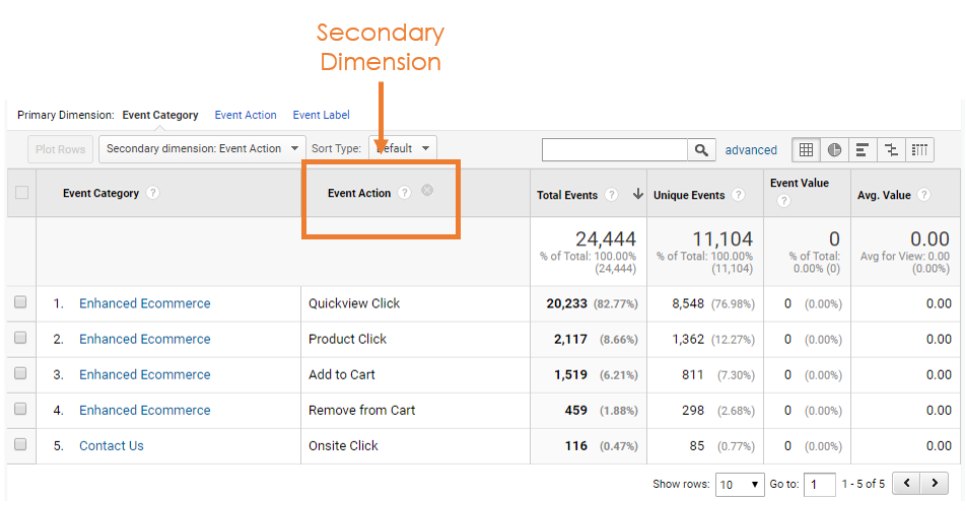Enhance Your Metrics: Understanding Google Analytics Secondary Dimension
Enhance Your Metrics: Understanding Google Analytics Secondary Dimension
Blog Article
Unlocking the Power of Secondary Dimension Analytics for Enhanced Data Insights and Decision-Making
In the world of data analytics, key measurements commonly take the limelight, yet the true depth of insights lies within the realm of second measurements. By using the power of secondary measurement analytics, organizations can unveil concealed trends, discover connections, and remove extra purposeful verdicts from their information.
Importance of Secondary Dimensions
Exploring the relevance of additional measurements in analytics introduces the surprise layers of information understandings vital for educated decision-making in different domains. Secondary dimensions offer a much deeper understanding of main information by offering added context and point of views. By integrating second dimensions into analytics, companies can remove extra nuanced and extensive understandings from their datasets.
One secret relevance of secondary dimensions is their capability to segment and categorize key information, enabling a much more thorough analysis of specific subsets within a dataset. This segmentation allows businesses to identify patterns, fads, and outliers that could not appear when considering the information all at once. Second dimensions aid in revealing correlations and dependences in between different variables, leading to more accurate forecasting and anticipating modeling - secondary dimension.
Moreover, secondary measurements play a crucial duty in improving information visualization and coverage. By including additional measurements to visualizations, such as graphs or charts, experts can produce extra interesting and insightful representations of data, promoting far better communication of findings to stakeholders. Overall, the combination of second measurements in analytics contributes in unlocking the full possibility of information and driving evidence-based decision-making.
Trick Advantages of Utilizing Additional Measurements
Making use of additional dimensions in analytics offers companies a critical advantage by augmenting the depth and granularity of data insights. By dissecting data making use of second dimensions such as time, location, tool kind, or individual demographics, organizations can uncover patterns, fads, and connections that may or else stay covert.
Additionally, the usage of secondary dimensions improves the context in which key information is translated. It offers a much more extensive view of the connections in between various variables, making it possible for organizations to make informed choices based on a more all natural understanding of their information. Furthermore, additional measurements help with the recognition of outliers, anomalies, and areas for optimization, ultimately bring about much more effective strategies and boosted results. By leveraging second dimensions in analytics, organizations can harness the complete possibility of their information to drive far better decision-making and achieve their company objectives.
Advanced Information Evaluation Techniques
A deep dive right into sophisticated information evaluation techniques reveals sophisticated techniques for removing important insights from complex datasets. One such method is equipment knowing, where formulas are employed to identify patterns within data, anticipate outcomes, and make data-driven choices. This approach enables the automation of analytical model structure, enabling the processing of large quantities of information at a faster speed than typical techniques.
An additional advanced strategy is anticipating analytics, which utilizes statistical algorithms and artificial intelligence methods to anticipate future results based upon historical information. By analyzing patterns and trends, services can anticipate consumer actions, market patterns, and prospective threats, equipping them to make proactive choices.
Furthermore, text mining and sentiment evaluation are useful methods for extracting understandings from disorganized data resources such as social networks remarks, customer evaluations, and survey feedbacks. By assessing text information, companies can comprehend consumer point of views, identify emerging fads, and enhance their solutions or products based on comments.
Enhancing Decision-Making Via Secondary Dimensions

Enhancing decision-making via second i was reading this measurements makes it possible for companies to make more notified and targeted calculated options. By segmenting customer information based on secondary dimensions like buying history or involvement degrees, firms can tailor their marketing methods to particular target market segments, leading to enhanced conversion rates and consumer fulfillment. Additional dimensions can help recognize relationships and relationships between different variables, enabling companies to make data-driven choices that drive development and productivity.
Executing Secondary Measurement Analytics
When integrating second dimensions in analytics, organizations can open much deeper insights that drive critical decision-making and enhance overall performance. Carrying out second dimension analytics requires a structured approach to make certain effective utilization of this powerful tool. The primary step is to recognize the vital metrics and dimensions that align with the organization's strategic goals. This requires recognizing the details inquiries the organization looks for to address and the information factors required to resolve them.

Furthermore, organizations need to leverage advanced analytics tools and modern technologies to improve the process of including additional dimensions. These devices can automate data handling, analysis, and visualization, enabling companies to concentrate on interpreting understandings instead of hand-operated data manipulation.
Verdict
In verdict, additional dimension analytics play a critical duty in enhancing information insights and decision-making procedures. By using advanced information analysis strategies and applying secondary measurements efficiently, companies can unlock the power of their data to drive tactical organization decisions. The vital benefits of using secondary dimensions can not be overemphasized, as they offer a much deeper understanding of information trends and connections. It is important for companies to utilize second measurement analytics to remain affordable in today's data-driven landscape.
In the realm of information analytics, key dimensions commonly take the limelight, however the true depth of understandings exists within the realm of additional measurements.Utilizing additional dimensions in analytics offers organizations a strategic advantage by boosting the deepness and granularity of information insights. By leveraging second dimensions in analytics, companies can harness the full possibility of their data to drive better decision-making and attain their business objectives.
Applying data recognition procedures and routine audits can assist maintain data quality and integrity.
By making use of advanced data analysis strategies and executing second dimensions properly, organizations can unlock the power of their data to drive tactical service decisions.
Report this page